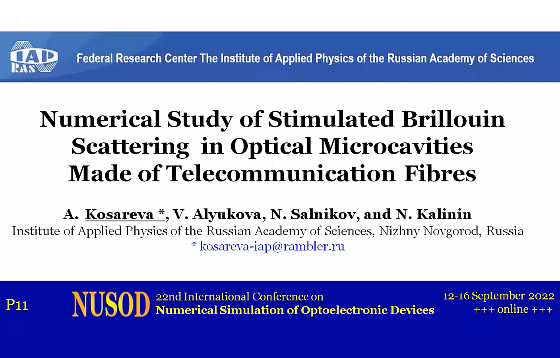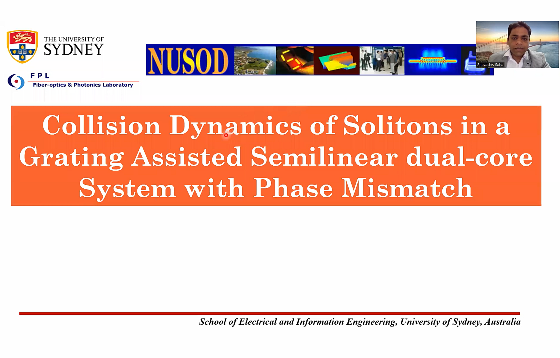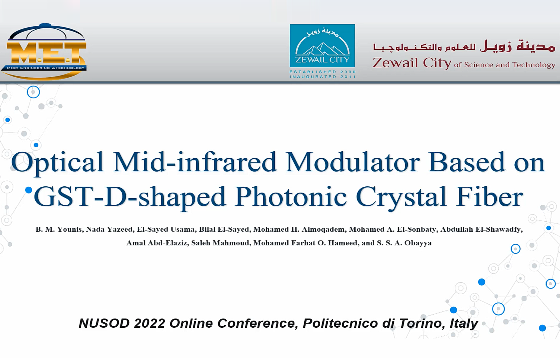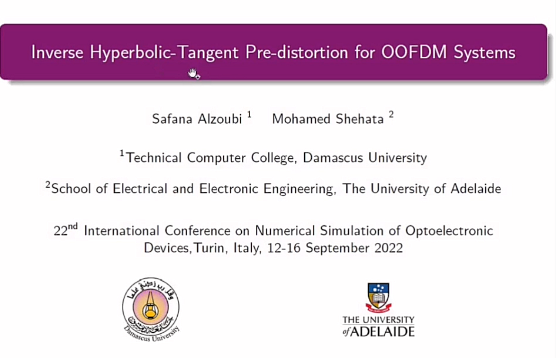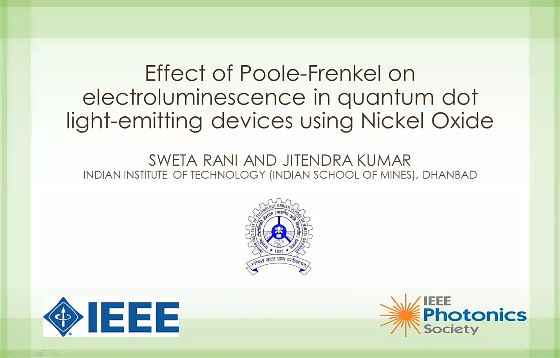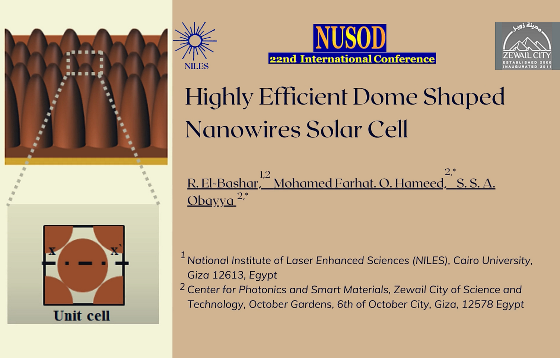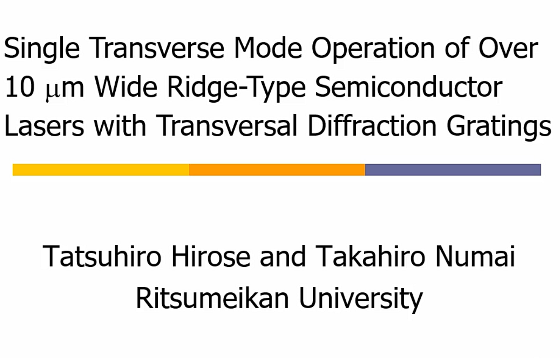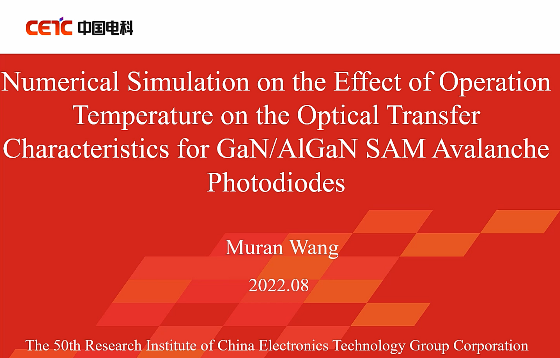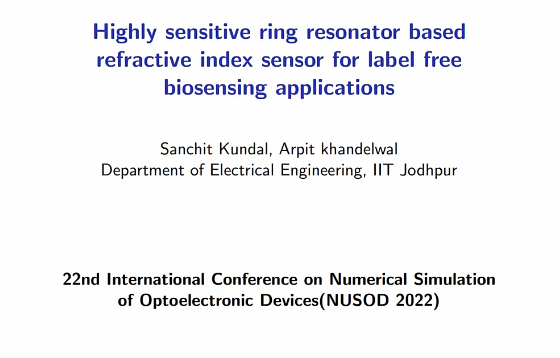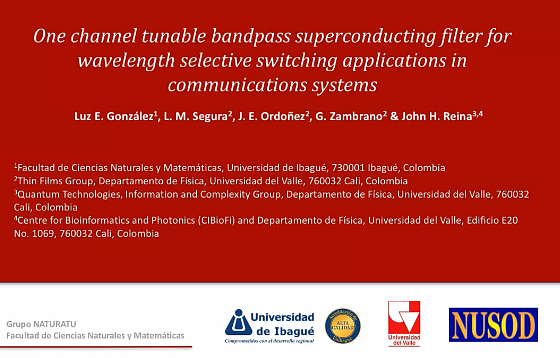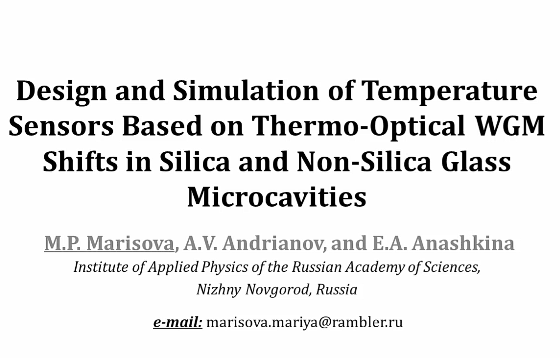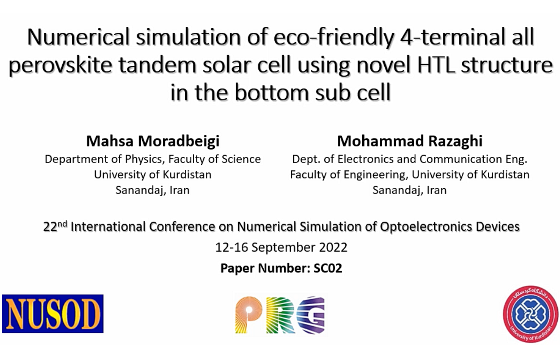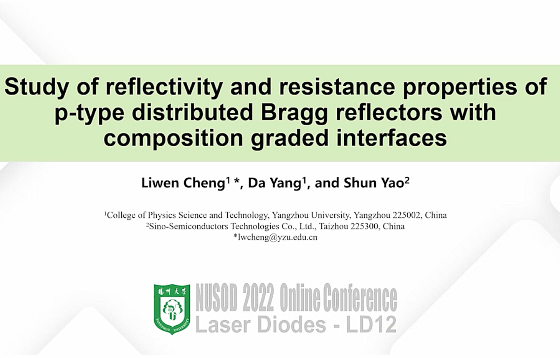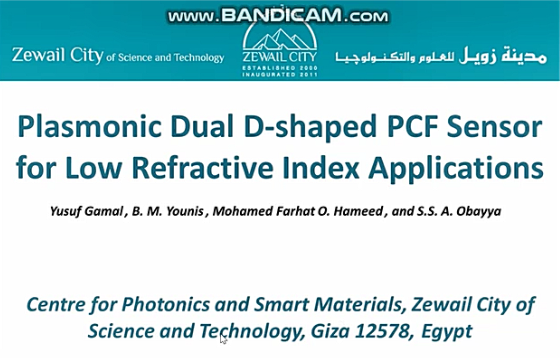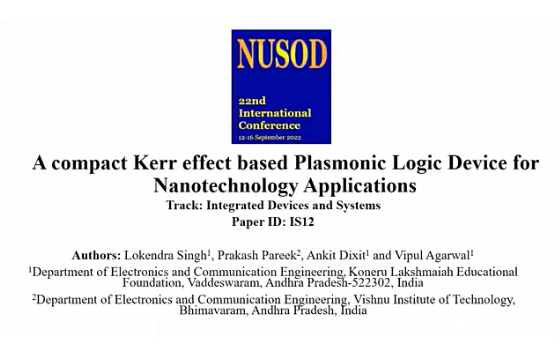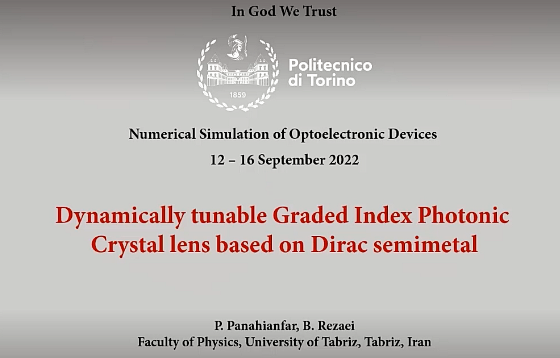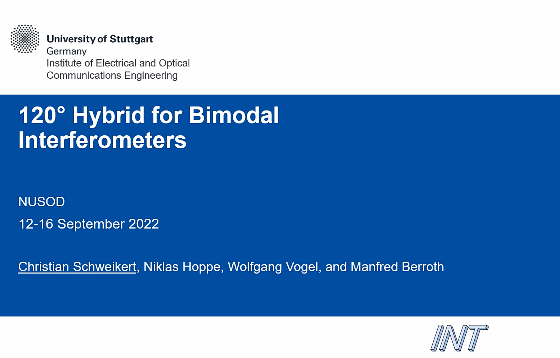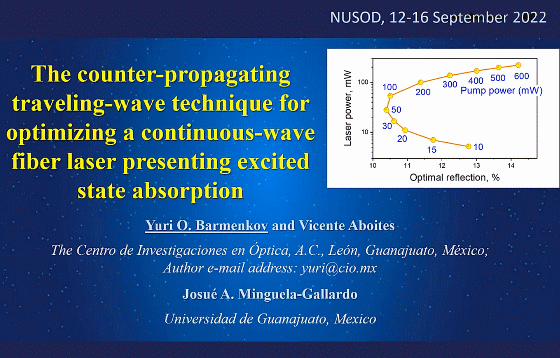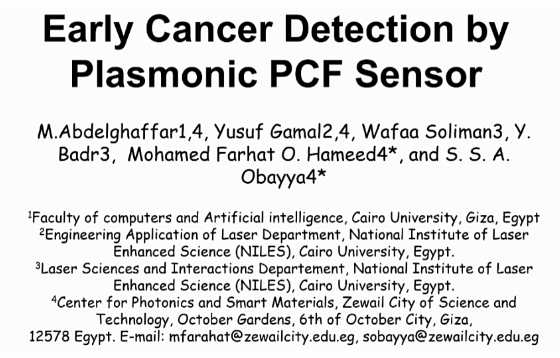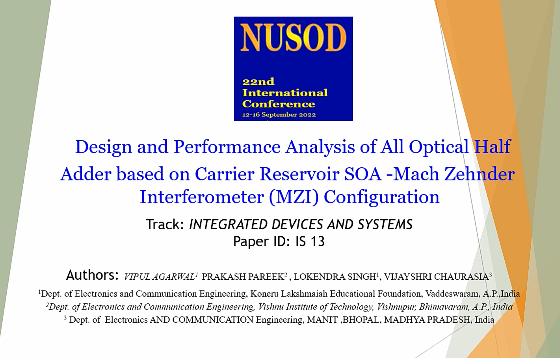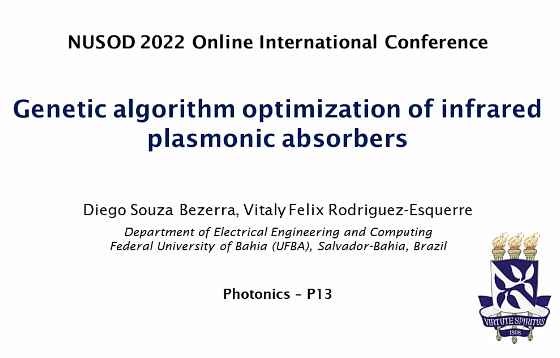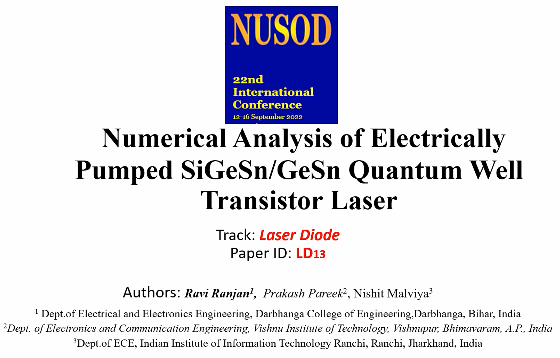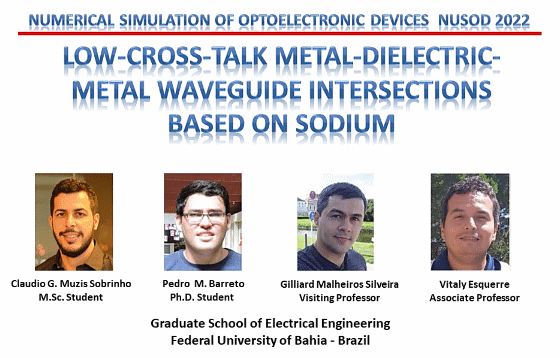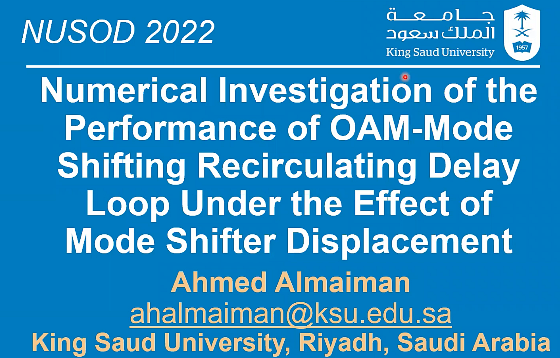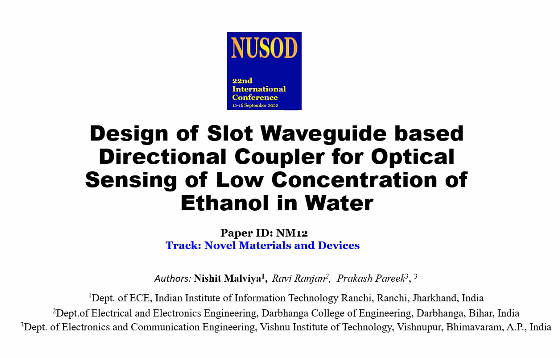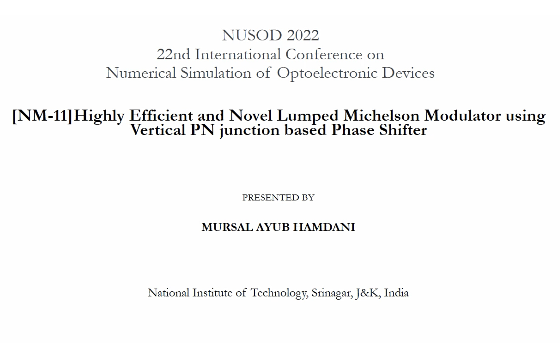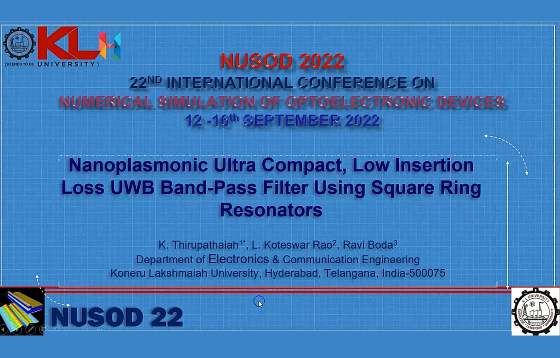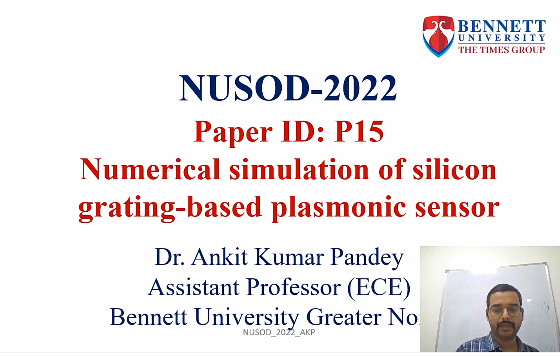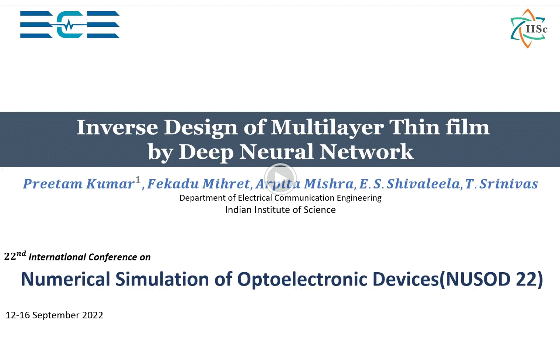Poster61 Videos



We numerically studied stimulated Brillouin scattering processes up to the 5th order is microcavities with various realistic diameters and Q-factors made of standard telecommunication fibres. Pump power thresholds were simulated for different parameters of the system. The larger the microcavity and lower Q-factors, the higher pump power thresholds are. It is also shown that thresholds […]
IS09 – Collision Dynamics of Solitons in a Grating Assisted Semilinear dual-core System with Phase Mismatch
The collision dynamics between two counterpropagating moving Bragg grating solitons and their outcomes in a model of semilinear dual-core Bragg-grating coupler with phase mismatch are investigated. The influence of gratings phase mismatch on the collision outcomes is also discussed.
NM14-Mid-infrared optical modulator based on D-shaped PCF
Recently, photonic crystal fibers (PCFs) have become of compelling interest due to their diverse applications, especially in the mid-infrared (mid-IR) wavelength regime. In this work, an optical mid-IR modulator based on D-shaped PCF with germanium-antimony-tellurium (GST) as a phase-changing material (PCM) is presented and analyzed. Because of the phase transition of the GST material between […]
IS15 – Inverse Hyperbolic-Tangent Pre-distortion for OOFDM Systems
We propose an inverse hyperbolic-tangent-based digital pre-distorter that can suppress the Mach-Zehnder modulator-induced harmonic distortions by about 13 dB for single-tone signals, while maintaining the peak-to-average power ratio in optical orthogonal frequency division multiplexed signals.
N05 – Effect of Poole-Frenkel emission on electroluminescence in quantum dot light emitting devices with Nickel Oxide layer
Theoretical analysis of hybrid quantum dot-light emitting devices incorporating CdSe/ZnS core/shell quantum dots and Nickel Oxide (NiO) as hole injection layer (HIL) has been carried out in this work. The replacement of organic HIL such as poly(3,4-ethylenedioxythiophene):poly(styrenesulfonate) (PEDOT:PSS) with solution-processed NiO layer has led to enhancement of current density and luminance in the device by […]
SC05 – Highly Efficient Dome Shaped Nanowires Solar Cell
The optical characteristics of Si dome-tapered nanowires (NWs) solar cell (SC) are reported and analyzed by using finite difference time domain method. The geometrical parameters are studied to maximize the light absorption and hence the ultimate efficiency and short circuit current density of the reported NWs SC. The dome-shaped NWs show better absorption enhancement than […]
LD11 – Single Transverse Mode Operation of Over 10 µm Wide Ridge-Type Semiconductor Lasers with Transversal Diffraction Gratings Tatsuhiro Hirose and Takahiro Numai
This paper reports on single transverse mode operation of a ridge-type semiconductor laser with transversal diffraction gratings for a mesa width over 10 µm when the number of periods is 160, the grating pitch is 428.7 nm, and the grating depth is 250 nm.
D08 – Numerical Simulation on the Effect of Operation Temperature on the Optical Transfer Characteristics for GaN/AlGaN SAM Avalanche Photodiodes
GaN/AlGaN avalanche photodiodes (APDs) have important application values and broad application potentials in the field of solar-blind ultraviolet (UV) detection. However, the self-heating effect has an obvious influence on the output characteristics of GaN/AlGaN APDs. In order to study the influence of self-heating temperature on its performance, the numerical model of GaN/AlGaN APDs is established […]
NM13-Highly sensitive ring resonator based refractive index sensor for label free biosensing applications
Ring resonator based label free refractive index biosensor is proposed for detecting glucose and hemoglobin concentrations. To improve device sensitivity and Q factor, various parameters of ring resonator are optimized. The designed ring resonator sensor can sense hemoglobin and glucose concentrations with a high sensitivity of 424 nm/RIU and Q factor of 802.
NM10 – One channel tunable bandpass superconducting filter for wavelength selective switching applications in communications systems
We design and evaluate the performance of optical filters that are built from one-dimensional photonic crystals (PhCs) amenable for integration into optical networks based on wavelength division multiplexing (WDM). The photonic heterostructures comprise the integration of a ferroelectric (BaTiO3), a dielectric (Y2O3), and a critical high-temperature superconductor material (YBa2Cu3O7−X) in between. Such nanosystems can allow […]
P12 – Design and Simulation of Temperature Sensors Based on Thermo-Optical WGM Shifts in Silica and Non-Silica Glass Microcavities
Sensing applications of dielectric microcavities with whispering-gallery modes (WGMs) have been actively studied in the recent years. Here we investigated theoretically temperature microsensors based on different glasses, including common silica glass, as well as special germanate, tungsten-tellurite, arsenic sulfide and arsenic selenide glasses. We developed numerical model describing sensing characteristics of the considered microcavities. We […]
SC02 – Numerical simulation of eco-friendly 4-terminal all perovskite tandem solar cell using novel HTL structure in the bottom sub cell
In this paper, we proposed a free-pb 4-terminal (4T) all perovskite tandem solar cell (APTSC) as reference with the power conversion efficiency (PCE) of 26.42% . First, a 100 nm MgF2 thin film is used as an antireflection layer (ARL) of the top sub cell to improve the total PCE of the reference structure. The […]
LD12 – Study of reflectivity and resistance properties of p-type distributed Bragg reflectors with composition graded interfaces
In this work, the reflectivity and series resistance of the p-type distributed Bragg reflectors (DBRs) in vertical cavity surface emitting lasers (VCSELs) under the different thickness of composition graded interface layers, Al composition of the high Al composition layers, Al composition of the low Al composition layers, and the number of DBR periods are simulated […]
P16 – Plasmonic Dual D-shaped PCF Sensor for Low Refractive Index Applications
Dual D-shaped (DD-shaped) plasmonic photonic crystal fiber (PCF) for refractive index sensing is designed and analyzed. In the proposed design, two gold nano-rods are attached to the two etched surfaces of the PCF to enhance the sensing characteristics. The surface plasmon (SP) modes excited at the metal/dielectric interfaces are strongly coupled to the PCF core […]
IS12 – A compact Kerr effect based Plasmonic Logic Device for Nanotechnology Applications
This work utilizes the vital property of Kerr effect of altering the phase of optical signal to numerically investigate the plasmonic XOR/XNOR logic device for nanotechnology applications. Extinction ratio (ER) and insertion loss (IL) of basic switching element (Mach-Zehnder interferometer) is evaluated and plotted as a function of length of interferometric arms. The obtained result […]
P14 – Dynamically tunable Graded Index Photonic Crystal lens based on Dirac semimetal
In this paper, we design a graded-index photonic crystal based on Dirac semimetals and simulate the light propagation in the proposed structure using two-dimensional finite-difference time-domain method. The numerical results indicate that the designed GRIN PC has focusing capability for incident light at terahertz frequency range, and its focal distance can be tuned through changing […]
P09 – 120° Hybrid for Bimodal Interferometers
An 120° hybrid for bimodal interferometers in the 220 nm silicon-on-insulator technology is presented. Three output signals enable an unambiguous phase detection over a 360°-range as well as a constant sensitivity. The length of the hybrid is only 190 µm with a simulated excess loss of 0.16 dB. Measurements combined with digital signal processing verify […]
P18 – The counter-propagating traveling-wave technique for optimizing a continuous-wave fiber laser presenting excited state absorption
We report results of simulation of a continuous-wave fiber laser with active medium presenting an excited state absorption. The laser was simulated using the counterpropagating traveling-wave technique with taking into account two laser waves propagating along the laser cavity in opposite directions, two waves of amplified spontaneous emission, and exited state absorption observed for both […]
NM15-Performance Optimization of Surface Plasmon Resonance based Sensors from the First Principle
Performance optimization of surface plasmon resonance (SPR) based sensors due to improvement in input optical coupling is theoretically investigated from the first principle. Various design parameters are optimized in a typical prism coupling Kretschmann configuration.
NM07 – Early Cancer Detection by Plasmonic PCF Sensor
Great research work has been studied for cancer detection due to its high death rate. In this paper, a novel design of photonic crystal fiber (PCF) biosensor based on surface plasmon resonance (SPR) is introduced and numerically analyzed for cancer cell detection. Full vectorial finite element method (FVFEM) is used throughout the numerical analysis of […]
IS13 – Design and Performance Analysis of All Optical Half Adder based on Carrier Reservoir SOA -Mach Zehnder Interferometer (MZI) Configuration
In this manuscript, Carrier reservoir SOA (CR-SOA) based half adder is proposed and simulated at 100 Gb/s. CR-SOA has fast carrier recovery, due to presence carrier reservoir which enables its use at higher data rates on the other hand conventional SOA suffers from slow carrier recovery which leads to unequal amplification of pulses. The obtained […]
P13 – Genetic algorithm optimization of infrared plasmonic absorbers
The absorption of a multiband absorber based on a periodical plasmonic grating has been optimized. The optical and geometrical parameters of the plasmonic structure which is composed of germanium and gold are determined by an efficient genetic algorithm. The electromagnetic response of the absorber is numerically obtained by using the frequency domain finite element method. […]
LD13 – Numerical Analysis of Electrically Pumped SiGeSn/GeSn Quantum Well Transistor Laser
The threshold current density of electrically pumped Sn incorporated group IV alloy based transistor laser (TL) is analyzed by proposing and designing a theoretical model for the same. Active region for the lasing action is formed by strain compensated GeSn single quantum well (QW) in the base of the transistor. The threshold current density for […]
P07 – Low-Cross-Talk Metal-Dielectric-Metal Waveguide Intersections Based on Sodium
We analyzed the transmission properties of two plasmonic waveguides crossing by using numerical simulations. The subwavelength width waveguides are composed of sodiumair-sodium. The crossing structure is composed by a compact cross-shaped resonant cavity with a four-fold symmetry. The results demonstrated the feasibility of using sodium as a low loss material for several applications for nanoplasmonic […]
IS11 – Numerical Investigation of the Performance of OAM-Mode Shifting Recirculating Delay Loop Under the Effect of Mode Shifter Displacement
We investigate the effect of OAM mode shifter displacement on the performance of the OAM-mode shifting recirculating delay loop by simulating the beam propagation using Kirchhoff-Fresnel diffraction. Simulation results indicate that 20 delayed replicas may be obtained with >10 dB signal-to-crosstalk ratio (SCR) if alignment is perfect and ℓshift=+1
NM12 – Design of Slot Waveguide based Directional Coupler for Optical Sensing of low concentration of Ethanol in Water
In this study, sensing of low concentration (0-10%) of ethanol in water is presented by refractive index sensing by silicon slot waveguide-based direction coupler. The significance spectral variation and sensitivity is observed to detect low concentration of ethanol in water.
NM11 – Highly Efficient and Novel Lumped Michelson Modulator using Vertical PN junction based Phase Shifter
Vertical PN depletion phase shifter based novel Common Mirror Michelson Modulator is proposed. It has a lower V, higher ER for a particular value of source impedance at a given bitrate and doping than conventional PN phase shifter based modulator.
P23 – Nanoplasmonic Ultra Compact, Low Insertion Loss UWB Band-Pass Filter Using Square Ring Resonators
This article presents the design and analysis of a nanoplasmonic ultra wide band (UWB) band-pass filter based on metal insulator metal (MIM) slot-waveguide using three square ring resonators (SRRs) for obtaining ultra wide band nature at optical frequencies. This filter shows the low insertion loss due to the zero coupling gaps and no mismatch between […]
P15 – Numerical simulation of silicon grating-based plasmonic sensor
This work reports on the application of silicon grating-enabled nanostructure for refractive index sensing application in the near-infrared region. This grating helps in launching the plasmon modes efficiently towards the flat metal film deposited with a thin Al2O3 layer. The normal incidence light is used which can be helpful for its integration with optical fiber. […]
N08 – Inverse Design of Multilayer Thin film by Deep Neural Network
Inverse Design of TiO2 − SiO2 based multilayer thin film for normal incidence of TM polarized light in visible region by Deep Neural Network is reported. The simulated and the target transmission spectra are closely following.

